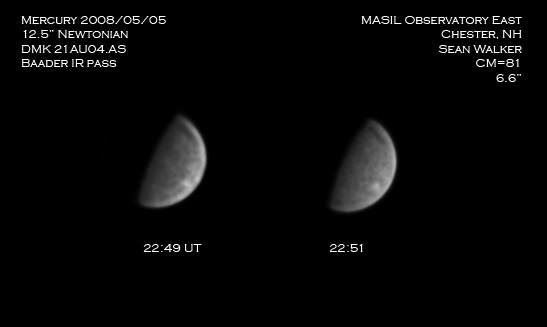Introduction
The BAA Mercury and Venus Section is devoted to the observational study of the two inferior planets . The section was founded in 1895, five years after the BAA was formed, and is therefore the oldest organisation in the world dedicated to this subject. Here is a further history of the section.
The section is currently directed by Dr Paul G Abel. The Director is assisted in his job by a Section Committee. The website manager position is currently vacant.
The section’s main functions are the collection of telescopic observations of the two planets, particularly Venus, and the collation of these into reports for the BAA Journal.
The Programme of the Section is available for download as a PDF and is published in the BAA Observing Guide. Here is some advice about imaging. Observations may be in the form of drawings, written reports, photographs or digital images. All observations should be submitted to the Director. Instructions for submitting observations may be found here.
Venus

Images of the clouds of Venus taken by Damian Peach using a C-14 SCT, a Lumenera SkyNYX-20 camera, and UV, violet and IR filters
The most important observations of Venus at the present time are directed towards:
- Ultraviolet imaging of Venus to study the rotation periods of the visible markings at different latitudes
- Imaging of the crescent Venus in the infrared to examine the night time thermal emission
- Searching for the Ashen Light of Venus, a controversial phenomenon which even after several centuries of study is not perfectly understood
Those who obtain excellent images may also wish to submit them to ESA for ground-based support for the Venus Express mission.
Traditionally, astronomers have observed Venus visually, and such studies, particularly with regards visibility of cusp-caps, cusp extensions and dichotomy timing are still welcome because they continue the historical record which is valuable for its own sake. The value of visual data can very clearly be seen in our recent published reports.
Drawings of the darker markings are also welcomed, though it has to be stated that drawings of features which are merely suspected are completely useless for our work. Here, what the obiturist of the first section director Henry McEwen called a ‘keen critical regard’ for one’s own work comes into play. Some observers have had greater success in detecting traces of the UV markings in the visible waveband by using a deep blue or violet filter, but others prefer to observe without a filter.
Visual studies have been incorporated with UV photography and imaging to improve our knowledge of the long-term rotation of the atmosphere: the combination works well in discussing data obtained over many years.
Mercury

Mercury imaged by Sean Walker using a 12.5″ Newtonian, a DMK 21AU04.AS camera, and IR filter
Mercury is a great challenge to observe, for when it appears in the morning or evening sky it is generally low down and boiling in turbulent air. Catching sight of it with the naked eye, or taking a wide angle camera shot – particularly if in conjunction with the Moon or a bright planet – is satisfying in itself.
Since the NASA Messenger mission, and the near-complete mapping of the surface of the innermost world at high resolution, Mercury has naturally received less attention from amateurs. Nonetheless, we set the challenge to obtain better and better images of the surface of this little world. Such images inform the historical perspective: they show that the bright patches seen visually are associated with ejecta from rayed craters, although the craters themselves are well below the level of resolution. We know that the great Caloris basin is associated with the curved space enclosed by the northern part of the ‘figure of five’ drawn by Schiaparelli, Antoniadi, Rudaux, Dollfus and others.
Visual observing is a real challenge. It is possible to contribute drawings to the Section, but unless they show significant detail they will regrettably be of no value, even if making them was a highly satisfying task for the individual.
Good luck with your observations and please let the Director know if he can be of any assistance in your work.
Return to the Mercury and Venus Section home page
| The British Astronomical Association supports amateur astronomers around the UK and the rest of the world. Find out more about the BAA or join us. |
